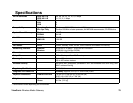ViewSonic Wireless Media Gateway 81
Bandwidth. The amount of transmission capacity that is available
on a network at any point in time. Available bandwidth depends on
several variables such as the rate of data transmission speed
between networked devices, network overhead, number of users,
and the type of device used to connect PCs to a network. It is
similar to a pipeline in that capacity is determined by size: the wider
the pipe, the more water can flow through it; the more bandwidth a
network provides, the more data can flow through it. Standard
802.11b provides a bandwidth of 11 Mbps; 802.11a and 802.11g
provide a bandwidth of 54 Mbps.
Bits per second (bps). A measure of data transmission speed
over communication lines based on the number of bits that can be
sent or received per second. Bits per second—bps—is often
confused with bytes per second—Bps. While "bits" is a measure of
transmission speed, "bytes" is a measure of storage capability. 8
bits make a byte, so if a wireless network is operating at a
bandwidth of 11 megabits per second (11 Mbps or 11 Mbits/sec), it
is sending data at 1.375 megabytes per second (1.375 MBps).
Bluetooth wireless technology. A technology specification for
linking portable computers, personal digital assistants (PDAs) and
mobile phones for short-range transmission of voice and data
across a global radio frequency band without the need for cables or
wires. Bluetooth is a frequency-hopping technology in the 2.4 GHz
frequency spectrum, with a range of 30 feet.
Bridge. A product that connects a local area network (LAN) to
another local area network that uses the same protocol (for


















